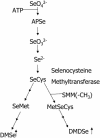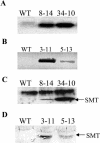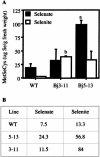Overexpression of selenocysteine methyltransferase in Arabidopsis and Indian mustard increases selenium tolerance and accumulation
- PMID: 14671009
- PMCID: PMC429391
- DOI: 10.1104/pp.103.026989
Overexpression of selenocysteine methyltransferase in Arabidopsis and Indian mustard increases selenium tolerance and accumulation
Abstract
A major goal of phytoremediation is to transform fast-growing plants with genes from plant species that hyperaccumulate toxic trace elements. We overexpressed the gene encoding selenocysteine methyltransferase (SMT) from the selenium (Se) hyperaccumulator Astragalus bisulcatus in Arabidopsis and Indian mustard (Brassica juncea). SMT detoxifies selenocysteine by methylating it to methylselenocysteine, a nonprotein amino acid, thereby diminishing the toxic misincorporation of Se into protein. Our Indian mustard transgenic plants accumulated more Se in the form of methylselenocysteine than the wild type. SMT transgenic seedlings tolerated Se, particularly selenite, significantly better than the wild type, producing 3- to 7-fold greater biomass and 3-fold longer root lengths. Moreover, SMT plants had significantly increased Se accumulation and volatilization. This is the first study, to our knowledge, in which a fast-growing plant was genetically engineered to overexpress a gene from a hyperaccumulator in order to increase phytoremediation potential.
Figures







Similar articles
-
Overexpressing both ATP sulfurylase and selenocysteine methyltransferase enhances selenium phytoremediation traits in Indian mustard.Environ Pollut. 2006 Nov;144(1):70-6. doi: 10.1016/j.envpol.2006.01.008. Epub 2006 Mar 2. Environ Pollut. 2006. PMID: 16515825
-
Overexpression of cystathionine-gamma-synthase enhances selenium volatilization in Brassica juncea.Planta. 2003 Nov;218(1):71-8. doi: 10.1007/s00425-003-1070-z. Epub 2003 Jul 9. Planta. 2003. PMID: 14618405
-
Production of Se-methylselenocysteine in transgenic plants expressing selenocysteine methyltransferase.BMC Plant Biol. 2004 Jan 28;4:1. doi: 10.1186/1471-2229-4-1. BMC Plant Biol. 2004. PMID: 15005814 Free PMC article.
-
Phytoremediation of selenium using transgenic plants.Curr Opin Biotechnol. 2009 Apr;20(2):207-12. doi: 10.1016/j.copbio.2009.02.001. Epub 2009 Mar 9. Curr Opin Biotechnol. 2009. PMID: 19269806 Review.
-
Selenium accumulation in plants--phytotechnological applications and ecological implications.Int J Phytoremediation. 2011;13 Suppl 1:166-78. doi: 10.1080/15226514.2011.568542. Int J Phytoremediation. 2011. PMID: 22046758 Review.
Cited by
-
Increase in Phytoextraction Potential by Genome Editing and Transformation: A Review.Plants (Basel). 2021 Dec 28;11(1):86. doi: 10.3390/plants11010086. Plants (Basel). 2021. PMID: 35009088 Free PMC article. Review.
-
Selenium Interactions with Algae: Chemical Processes at Biological Uptake Sites, Bioaccumulation, and Intracellular Metabolism.Plants (Basel). 2020 Apr 19;9(4):528. doi: 10.3390/plants9040528. Plants (Basel). 2020. PMID: 32325841 Free PMC article. Review.
-
Selenium accumulation by plants.Ann Bot. 2016 Feb;117(2):217-35. doi: 10.1093/aob/mcv180. Epub 2015 Dec 29. Ann Bot. 2016. PMID: 26718221 Free PMC article. Review.
-
An Overview of Selenium Uptake, Metabolism, and Toxicity in Plants.Front Plant Sci. 2017 Jan 11;7:2074. doi: 10.3389/fpls.2016.02074. eCollection 2016. Front Plant Sci. 2017. PMID: 28123395 Free PMC article. Review.
-
Selenate tolerance and selenium hyperaccumulation in the monocot giant reed (Arundo donax), a biomass crop plant with phytoremediation potential.Environ Sci Pollut Res Int. 2018 Nov;25(31):31368-31380. doi: 10.1007/s11356-018-3127-3. Epub 2018 Sep 8. Environ Sci Pollut Res Int. 2018. PMID: 30196460
References
-
- American Medical Association (1989) Home Medical Encyclopedia, Vols 1 and 2. Random House, New York
-
- An G, Ebert P, Mitra A, Ha S (1988) Binary vectors. In SB Gelvin, RA Schilperoort, eds, Plant Molecular Biology Manual. Kluwer Academic Publishers, Dordrecht, The Netherlands, pp A3, 1-19
-
- Bañuelos GS, Ajwa HA, Mackey M, Wu L, Cook C, Akohoue S, Zambruzuski S (1997) Evaluation of different plant species used for phytoremediation of high soil selenium. J Environ Qual 26: 639–646
-
- Bañuelos G, Schrale G (1989) Plants that remove selenium from soils. Calif Agric 43: 19–20

